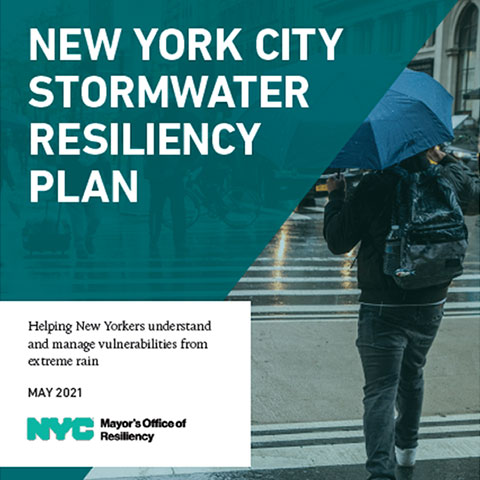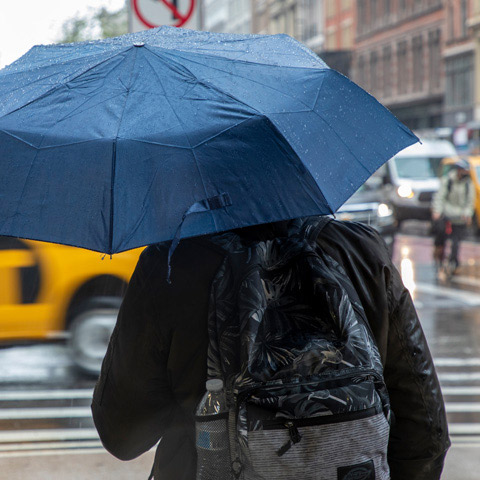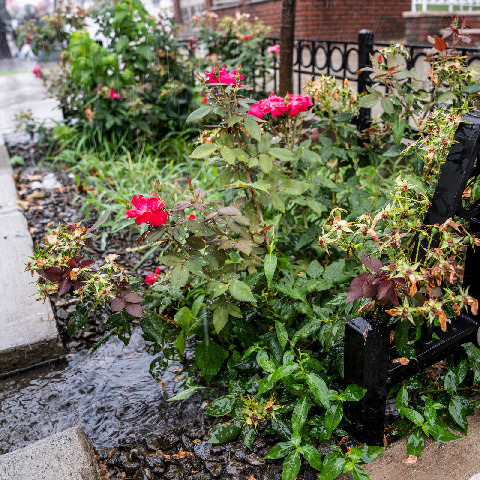
 Environmental Protection311
Environmental Protection311 Search all NYC.gov websites
Search all NYC.gov websites
Cloudburst Management
A “cloudburst” is a sudden, heavy downpour where a lot of rain falls in a short amount of time. Cloudbursts can cause flooding, damage property, disrupt critical infrastructure, and pollute New York’s rivers and Harbor. Cloudburst management implements a combination of methods that absorb, store, and transfer stormwater to minimize flooding from cloudburst events. Using grey infrastructure, like sewer pipes and underground storage tanks, and Green Infrastructure, like trees and Rain Gardens, cloudburst management can minimize damage to property and infrastructure by reducing strain on the Sewer System. Cloudburst management projects may also feature special community amenities and open spaces that can be used by the public.
Cloudburst Infrastructure
When considering potential cloudburst infrastructure, the City looks at factors such as:
- the array of physical features, both natural and constructed,
- the number and size of area storm drain and sewer pipes,
- available space for new projects,
- below ground conditions, such as soil quality and existing utility infrastructure,
- the possibility of connecting green and gray infrastructure, and
- the social and economic conditions of the people and businesses in a community.
Timeline
In January 2023, the Mayor announced an expansion of the city’s cloudburst program to four new sites as part of ongoing resiliency efforts to better prepare for intense rain events. Supported with nearly $400 million in capital funds, these specially designed, built, and engineered infrastructure projects will protect residents and property in Corona and Kissena Park, Queens, Parkchester, Bronx, and East New York, Brooklyn from future extreme weather brought about by climate change. These locations were selected considering physical vulnerability, social and economic factors, and below ground conditions. There will be more locations to come as funding is secured.
- Download the Cloudburst Management in NYC for Long-Term Resilience Presentation
- Download the Cloudburst Program Citywide Update Presentation
Get Involved
The City needs your help during the cloudburst neighborhood planning process to identify the best projects for your neighborhood and to learn about stormwater in your area. If you would like to join the mailing list and learn about future events and opportunities to get involved, visit Newsletters and subscribe to one or all of our cloudburst email lists.
The City is also seeking public input on cloudburst projects through a community board consultation process. To find out which community board you live in and get involved in the planning process for your neighborhood, Look up Your Community Board.
Flood Preparedness and Prevention Resources
You can reference the NYC Stormwater Flood Maps to understand if your residence or place of business is at risk of rainfall-based flooding in the future. If you would like to report flood-related issues, such as ponding, street flooding, or sewer backups, please call 311. The City receives and responds to this information and uses it to plan future stormwater management projects.
It is always a good idea to be prepared for a storm. If your residence or place of business is in an area of elevated risk, use the following resources to take preventative measures:
- Make an Emergency Plan and learn the safest route from your home or work to safe, high ground in case you need to evacuate
- Stay informed by signing up for alerts from Notify NYC or calling 311
- For homeowners, protect your home from floods by following the tips in the Homeowner’s Guide to Rain Event Preparedness
- Learn about Flooding from NYC Emergency Management
- Learn more Flood Prevention tips
Cloudburst Pilot Projects
Through a partnership with the City of Copenhagen, the New York City Department of Environmental Protection published a Cloudburst Resiliency and Planning Study in 2017.
As a result of the cloudburst study, DEP is testing the implementation of cloudburst management at the NYC Housing Authority’s (NYCHA) South Jamaica Houses. Download the NYCHA: South Jamaica Houses Cloudburst Master Plan 2018 for more information.
DEP has also begun to implement several other cloudburst pilot projects including: Clinton Houses, in East Harlem, Manhattan; St. Albans/Addisleigh Park, Queens; and Beach 67th Street in Far Rockaway, Queens.
Stormwater Resiliency Plan
Helping New Yorkers understand and manage vulnerabilities to extreme rain.
Environmental Justice
Plan to identify and address climate and environmental justice issues in New York City.
Rainfall Ready NYC
A plan to prepare the city government and New Yorkers for more extreme rainfall in the future
Increasing Stormwater Resilience
Our long term vision in the face of climate change.







